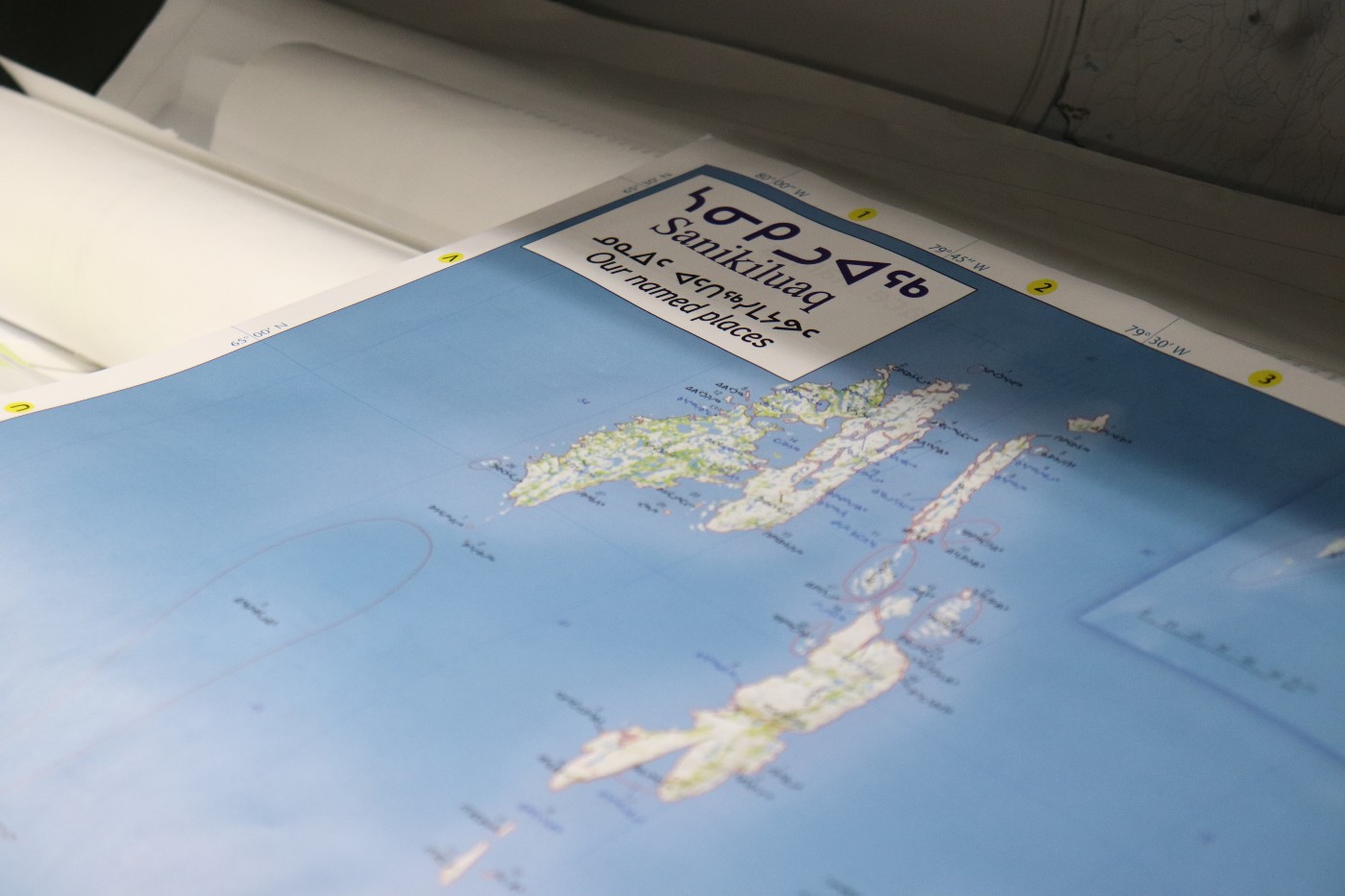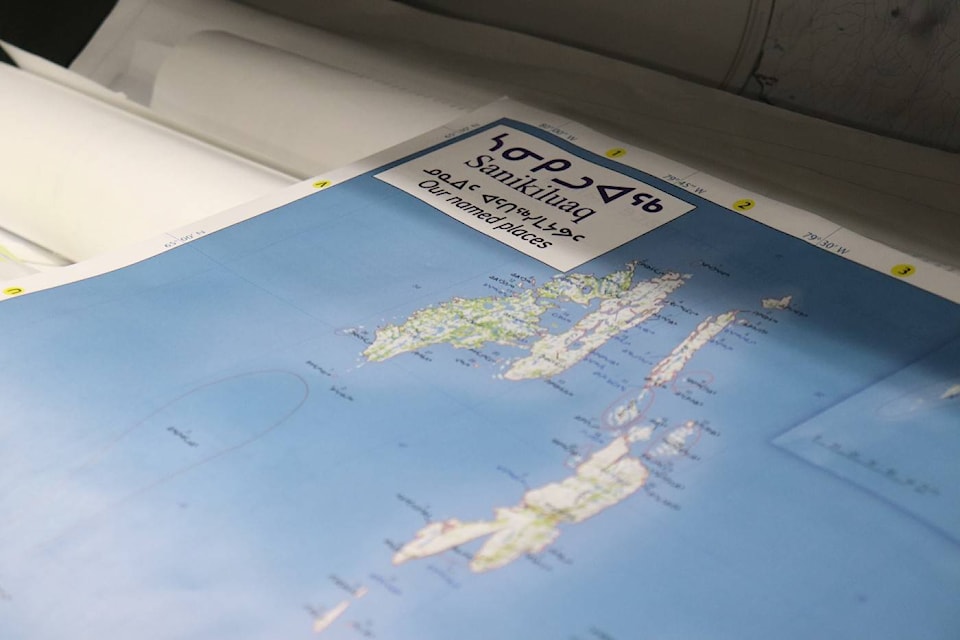For more than 30 years the Inuit Heritage Trust’s Place Names Program has recorded Elders’ knowledge of the land and hundreds of traditional place names all over Nunavut.
The program’s mandate comes from the Nunavut Land Claims Agreement.
“The Government of Nunavut has a Department of Culture and Heritage, they have a toponymist. The toponymist is the person in Nunavut who receives applications for name changes. Our role is to bring the traditional names, we bring names that have always been there and basically put them on paper,” said Lynn Peplinski, traditional place names manager.
With regards to documenting local names for lakes, inlets, ends of inlets, hills and other landmarks, it is the people who live in an area who get priority on deciding local names.
With many places in Nunavut having been taken over by European names, the process of bringing back traditional place names helps Inuit restore the locations as they were originally recognized.
“There’s the history of European travellers and explorers whose names are there, but Inuit have been there long-before and they’re still here.”
A map from Franz Boas, an American anthropologist in the late 19th century/early 20th century who documented around 800 place names in the 1880s in the Cumberland Sound area, shows that 100 years later many of those names are still there.
“We put those names to interviews, confirmed spellings and everything, produce maps with those names and gave them to the local community,” she said.
Peplinski explained this is “So the younger people can have access to them, so the transfer of the knowledge can continue.”
As Inuit were largely nomadic prior to colonization, there are traditional place names literally all over the territory, many of which are far away from contemporary Inuit communities. That isn’t the case today and many place names in Nunavut are at risk of being lost.
“Now people don’t do that, they’re focused in town. They go out short distances to hunt, they don’t travel necessarily as whole families. Young hunters don’t necessarily learn the place names, especially the place names that are too far, further than a day’s ride by snowmobile or boat.”
The reception to this project has been quite positive in many of the communities themselves.
“They have received it very well, the compliments we get from the communities as well is appreciative of what we have done,” said Zipporah Ungalaq, traditional place names co-ordinator, who ensures all of the Inuktut names are correct in writing, map locations and pronunciation according to each community’s dialect.
“People love these maps, it’s kind of visceral almost, they feel so strongly about having access to this information. Because it represents so much, if you live in Arctic Bay or any community, you know this information is disappearing. This is a tangible source of traditional knowledge, I think for a lot of people this is really important,” adds Peplinski.
Many of the traditional names associated with the numerous landmarks and inlets all over the territory are evocative of a place’s history or traits the landmarks exhibit.
“For Indigenous names they’re descriptive, like there’s bad ice over there or there’s a current there. They tell you about the place, like it’s a great winter camping place, et cetera,” said Peplinski.
In Frobisher Bay (Tasiujarjuaq) alone, there are dozens of different distinct names: Long Island in Inuktitut is Ukaliqturliq (place where rabbits are plentiful, good habitat for rabbits). Further out on the bay, Sale Island to Inuit is known as Qaaqtalik (mattress of caribou skins was left here long ago), for example.
“This is the thing with these names, it really makes the land come alive, if you speak fluent Inuktitut and you hear the names, it just evokes images of what you’re going to find there unlike Frobisher Bay, (which) doesn’t tell you anything,” Peplinski explained.
“A lot of these land features are named after a body part for instance, or what you did over there or how you found this place,” added Ungalaq.
There has been a lot of work done on this and the two feel like they are now reaching a turning point in being able to document traditional place names.
“When we were doing the work in Arviat not too long ago, the Elders were telling us we know there’s a lot more names further out from Arviat. The further west you go it’s harder to get there. Yet a long time ago people did live out there, the Elders were saying we know there’s a lot of names out there, but nobody is alive anymore to tell us.”
Similar situations have cropped up in other communities. Peplinski adds the Elders in Iqaluit she talked to in the early 1990s are mostly not around anymore, they were faced with a similar situation when they visited Sanirajak.
“People showed up, because they wanted to know the names, but they didn’t show up with expertise, we were looking for experts and they were too young,” she added.
As a result of this, many parts of Nunavut – despite having been inhabited by nomadic Inuit previously – are left blank, such as the area on Qikiqtani where the Bowman Wildlife Sanctuary is currently located.
“There’s no way this should be blank, I travelled this area in the late 90s, this is where geese come, there’s geese molting, there’s thousands and thousands of geese. You would think it would have been there, that’s a source of food,” Peplinski said. “But there’s nobody alive that knows the names.”
She adds if they hadn’t done this work over the previous three decades, “there would be a lot fewer names on these maps.”


